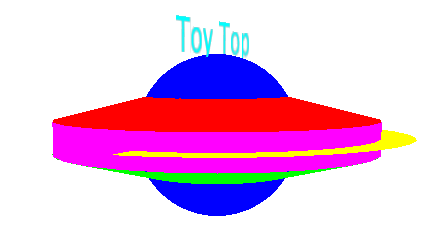The JSL example below uses Push Matrix and Pop Matrix to position pieces of the toy top and then return to the origin. This is faster than using the Translate command a second time in reverse.
toyTop = Scene Display List();
toyTop << Push Matrix;
toyTop << Translate( 0, 0, .1 );
toyTop << Color( 1, 0, 0 ); // red
toyTop << Cylinder( 1, .2, .2, 25, 5 );
// baseRadius, topRadius, height, slices, stacks
toyTop << Pop Matrix;
toyTop << Push Matrix;
toyTop << Translate( 0, 0, -.1 );
toyTop << Rotate( 180, 1, 0, 0 );
toyTop << Color( 0, 1, 0 ); // green
toyTop << Cylinder( 1, .2, .2, 25, 5 );
toyTop << Pop Matrix;
toyTop << Color( 0, 0, 1 ); // blue
toyTop << Sphere( .5, 30, 30 ); // radius, slices, stacks
toyTop << Color( 1, 1, 0 ); // yellow
toyTop << Partial Disk( 1, 1.2, 25, 2, 0, 270 );
// innerRadius, outerRadius, slices, rings, startAngle, sweepAngle
toyTop << Push Matrix;
toyTop << Translate( 0, 0, -.1 );
toyTop << Color( 1, 0, 1 ); // magenta
toyTop << Cylinder( 1, 1, .2, 25, 3 );
// baseRadius, topRadius, height, slices, stacks
toyTop << Pop Matrix;
toyTop << Push Matrix;
toyTop << Rotate( 90, 1, 0, 0 );
toyTop << Translate( 0, .5, 0 );
toyTop << Color( 0, 1, 1 ); // cyan
toyTop << Text( "center", "baseline", .2, "Toy Top" );
toyTop << Pop Matrix;
scene = Scene Box( 600, 600 ); // make a scene box...holds an OpenGL scene
New Window( "Example 3", scene ); // put the scene in a window
scene << Perspective( 45, 3, 7 );
scene << Translate( 0.0, 0.0, -4.5 );
scene << Rotate( -85, 1, 0, 0 );
scene << Rotate( 65, 0, 0, 1 );
scene << Call List( toyTop );
scene << Update; // update the display box
There are some cases where you want to replace the current matrix on the stack. For these cases, use the Load Matrix command.
Load Matrix(m)
where m is a 4x4 JMP matrix that is loaded onto the current matrix stack.
Similar is the Mult Matrix command
Mult Matrix(m)
When the Mult Matrix command is issued, the matrix on the top of the current matrix stack is multiplied by m.
[1 0 0 x
0 1 0 y
0 0 1 z
0 0 0 1]
Rotation about x-axis:
[1 0 0 0
0 c -s 0
0 -s c 0
0 0 0 1]
Rotation about y-axis:
[c 0 s 0
0 1 0 0
-s 0 c 0
0 0 0 1]
Rotation about z-axis:
[c -s 0 0
s c 0 0
0 0 1 0
0 0 0 1]
// first way uses matrix
gl << Push Matrix;
xt = Identity( 4 ); // translate this one left by .75
xt[1, 4] = -.75;
xr = Identity( 4 ); // rotate this one, cos needs radians, not degrees
xr[2, 2] = Cos( 3.14159 * a / 180 );
xr[2, 3] = -Sin( 3.14159 * a / 180 );
xr[3, 2] = Sin( 3.14159 * a / 180 );
xr[3, 3] = Cos( 3.14159 * a / 180 );
yr = Identity( 4 );
yr[1, 1] = Cos( 3.14159 * a / 180 );
yr[1, 3] = Sin( 3.14159 * a / 180 );
yr[3, 1] = -Sin( 3.14159 * a / 180 );
yr[3, 3] = Cos( 3.14159 * a / 180 );
zr = Identity( 4 );
zr[1, 1] = Cos( 3.14159 * a / 180 );
zr[1, 2] = -Sin( 3.14159 * a / 180 );
zr[2, 1] = Sin( 3.14159 * a / 180 );
zr[2, 2] = Cos( 3.14159 * a / 180 );
gl << Mult Matrix( xt * xr * yr * zr );
// order of multiplication matters with matrices
gl << Arcball( dl, 1 );
gl << Pop Matrix;
// second way uses functions
gl << Push Matrix;
gl << Translate( .75, 0, 0 ); // translate this one right by .75
gl << Rotate( a, 1, 0, 0 ); // rotate this one in degrees
gl << Rotate( a, 0, 1, 0 ); // order of operations also matters here
gl << Rotate( a, 0, 0, 1 );
gl << Arcball( dl, 1 );
gl << Pop Matrix;
